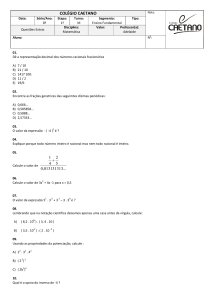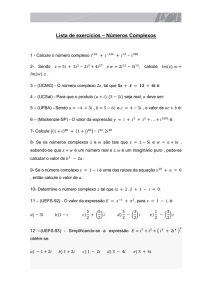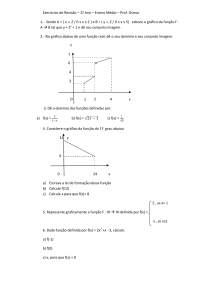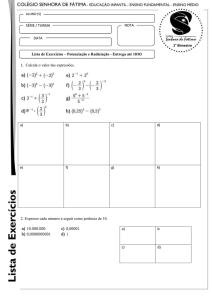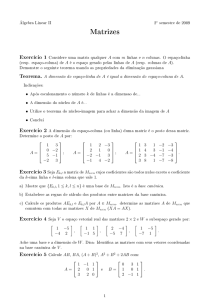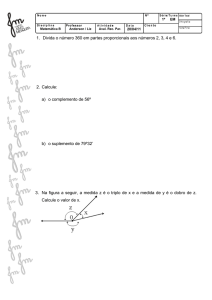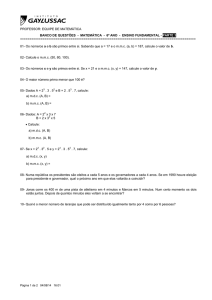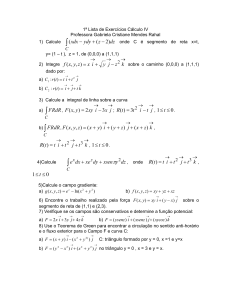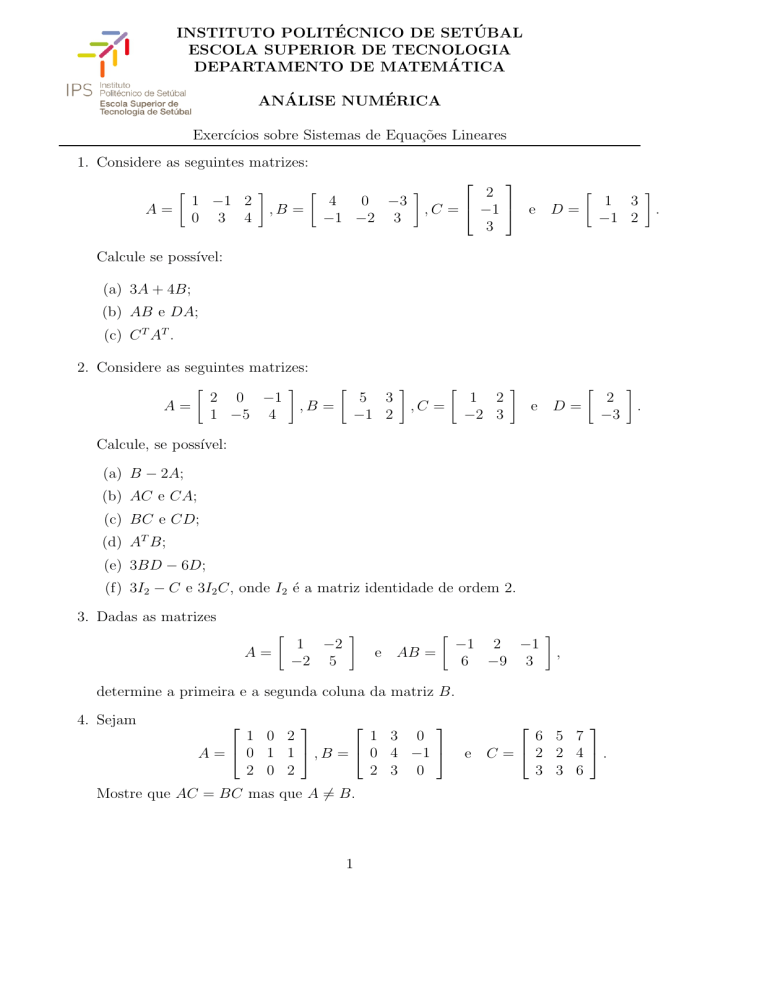
INSTITUTO POLITÉCNICO DE SETÚBAL
ESCOLA SUPERIOR DE TECNOLOGIA
DEPARTAMENTO DE MATEMÁTICA
ANÁLISE NUMÉRICA
Exercı́cios sobre Sistemas de Equações Lineares
1. Considere as seguintes matrizes:
[
A=
1 −1 2
0 3 4
]
[
,B =
4
0 −3
−1 −2 3
]
[
]
2
1 3
, C = −1
e D=
.
−1 2
3
Calcule se possı́vel:
(a) 3A + 4B;
(b) AB e DA;
(c) C T AT .
2. Considere as seguintes matrizes:
]
]
[
]
[
]
[
[
2
1 2
5 3
2 0 −1
.
e D=
,C =
,B =
A=
−3
−2 3
−1 2
1 −5 4
Calcule, se possı́vel:
(a) B − 2A;
(b) AC e CA;
(c) BC e CD;
(d) AT B;
(e) 3BD − 6D;
(f) 3I2 − C e 3I2 C, onde I2 é a matriz identidade de ordem 2.
3. Dadas as matrizes
[
A=
1 −2
−2 5
]
[
e AB =
−1 2 −1
6 −9 3
]
,
determine a primeira e a segunda coluna da matriz B.
4. Sejam
1 0 2
1 3 0
A = 0 1 1 , B = 0 4 −1
2 0 2
2 3 0
Mostre que AC = BC mas que A ̸= B.
1
6 5 7
e C = 2 2 4 .
3 3 6
INSTITUTO POLITÉCNICO DE SETÚBAL
ESCOLA SUPERIOR DE TECNOLOGIA
DEPARTAMENTO DE MATEMÁTICA
ANÁLISE NUMÉRICA
Exercı́cios sobre Sistemas de Equações Lineares
5. Determine x, y, z, w ∈ R, tais que
[
] [
] [
]
x y
x 6
4
x+y
3
=
+
.
z w
−1 w
z+w
3
6. Sejam
[
A=
]
1 1
1 1
[
1 −2
−1 2
e B=
]
.
Mostre que AB = [0]. O que se pode concluir quanto à lei do anulamento do produto nas
matrizes ?
[
7. Considere a matriz invertı́vel
A=
1 2
2 1
]
.
Utilize a definição de matriz inversa para determinar a matriz inversa de A.
[
]
( T )−1
2 −3
8. Sabendo que A
=
, determine a matriz A.
4 0
9. Calcule os determinantes das matrizes:
[
A=
3 −2
4 5
]
[
a−b
a
a
a+b
,B =
1
a 0 0
2
D= a b 0 eE=
0
0 b c
0
10. Considere a matriz
]
2 0 1
,C = 1 2 1 ,
0 1 2
0 5
1 0
2 1
1 −2
1 2 −2 3
3 −1 2
0
.
A=
1 0
2
1
1 0
2 −3
Determine os seguintes complementos algébricos:
(a) ∆31 ;
2
1
1
.
1
3
INSTITUTO POLITÉCNICO DE SETÚBAL
ESCOLA SUPERIOR DE TECNOLOGIA
DEPARTAMENTO DE MATEMÁTICA
ANÁLISE NUMÉRICA
Exercı́cios sobre Sistemas de Equações Lineares
(b) ∆23 ;
(c) ∆42 .
11. Seja
1
m
A = [aij ] =
0
n
2
1
1
1
0
1
2
0
1
0
.
2
1
Calcule |A| utilizando o desenvolvimento de Laplace ao longo da primeira coluna da matriz
sabendo que os elementos a21 e a41 são iguais aos respectivos complementos algébricos.
1 1 1 1
1 1 1 2
12. Seja A =
1 1 a 1 , a, b ∈ R.
1 b 1 1
(a) Calcule |A| . Em que condições A é invertı́vel?
(b) Sejam a = 3 , b = 2, B e C matrizes quadradas de ordem 4 e C uma matriz invertı́vel
tais que (AT )−1 = C −1 BC. Calcule |B|.
1 1 0
13. Seja A = 1 1 1 .
0 2 1
(a) Calcule a matriz adjunta de A;
(b) Mostre que A é invertı́vel e determine a sua inversa.
14. Verifique se a seguinte matriz é invertı́vel e, em caso afirmativo, determine a sua inversa
2 1 −1
A = 1 3 2 .
−1 3 1
15. Considere a seguinte matriz
a
1
A=
0
0
1
a
1
0
a
1
1
0
1
a
, a ∈ R.
1
2
Diga para que valores de a se verifica A−1 = adj(A).
3
INSTITUTO POLITÉCNICO DE SETÚBAL
ESCOLA SUPERIOR DE TECNOLOGIA
DEPARTAMENTO DE MATEMÁTICA
ANÁLISE NUMÉRICA
Exercı́cios sobre Sistemas de Equações Lineares
2 1 1
16. Seja A = 0 1 1 .
0 −1 1
(a) Calcule a matriz adjunta de A;
(b) Moste que A é invertı́veç e determine a sua inversa.
17. Considere as seguintes matrizes:
[
]
1 2 −1
1 2 3
2
3
A = 2 4 1 , B = −1 2 0 , C =
1 −1
−2 0 3
−1 1 1
[
D=
1 2
1 2
]
−4 −3 −3
0
1 .
e E= 1
−2 −3 −1
(a) Verifique se estas matrizes são invertı́veis;
(b) Calcule, quando possı́vel, as matrizes inversas.
18. Considere a seguinte matriz de ordem 4:
k 2 −1 0
0 −1 0 2
, k ∈ R.
B=
1 0
1 k
0 1
0 1
(a) Calcule a expressão do determinante da matriz B;
(b) Indique, justificando, para que valores de k a matriz B é invertı́vel.
19. Considere a seguinte matriz
0 2 −1
A = 1 1 1 .
1 1 0
(a) Calcule o determinante da matriz A;
(b) Verifique se a matriz A é invertı́vel e, em caso afirmativo, calcule a sua inversa.
4
INSTITUTO POLITÉCNICO DE SETÚBAL
ESCOLA SUPERIOR DE TECNOLOGIA
DEPARTAMENTO DE MATEMÁTICA
ANÁLISE NUMÉRICA
Exercı́cios sobre Sistemas de Equações Lineares
20. Represente matricialmente os seguintes sistemas de equações lineares e resolva-os pelo método
de eliminação de Gauss:
x+y+z =1
x+y =1
(a)
3x + 2y = 4
x−y =0
x+y+w =3
(b)
z−w =0
x+y+z =1
2x + y + z = 1
(c)
3x + 2y + 2z = 1
3x − 2y + z = 1
x + 3y − z = 10
(d)
3x − 2y + 2z = 2
x − 2y = 1
2x + y + 3z = 1 .
(e)
−x + 2y + z = 0
x+y−z =2
x−y−z =1
(f)
x+y+z =0
x + 2y + z = 3
−3x + 5y + 8z = 2
(g)
4x − y − 5z = 3
x+y+w =1
y + 2z + w = 0
(h)
x + y + z + 3w = 1
−3y − 2z + w = 4
5

